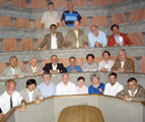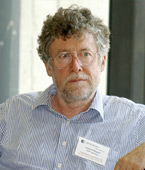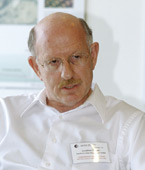ICFA: The committee behind the future of particle colliders
By Mike Perricone
If the proposed International Linear Collider (ILC) completes the evolution from physicists' dream to discovery machine, Jonathan Dorfan will know when and where the transforming moment occurred: August 20, 2004, in Beijing, China.
Meeting that day, the International Committee for Future Accelerators (ICFA) endorsed the findings of the International Technology Recommendation Panel for the ILC. The 12-member panel, chaired by Barry Barish of the California Institute of Technology, recommended superconducting accelerating structures at 2 kelvin, rather than "warm" accelerating structures at room temperature, for the design of the electron-positron collider.
As director of Stanford Linear Accelerator Center, a headquarters for warm technology, Dorfan was disappointed. But as chair of ICFA, Dorfan saw the fulfillment of the committee's decade-long effort to shape the future of particle physics. "When ICFA made its decision in Beijing, I felt that was a real turning point," says Dorfan, recently succeeded as chair by Albrecht Wagner of DESY. "The choice on the technical direction was hard for me, because I thought it would be warm technology. But that wasn't the point. To me, what we were seeing was the birth of the ILC."
|
The consensus was beyond symbolic. Practical details had already been hammered out to dispel doubts about ICFA's ability to act effectively on its commitment to international cooperation. The stakes could not have been higher in Beijing: as Dorfan points out, "the world was watching; the governments were watching," and specifically the funding agencies of those governments. What they saw was a smooth and genuine performance.
"Gathered together as ICFA in Bejing, we received the report from Barry on the superconducting technology choice, we heard the rationale, and ICFA unanimously endorsed it," Dorfan says in a rush. "Neil Calder [of SLAC] and Judy Jackson [of Fermilab] had already forged an international team of communicators, and they were sitting in the next room. We had prepared two press releases, one to announce cold technology and one, warm technology. Once we had the answer, we issued the first press release ever to come out under the names of all the world's major particle physics laboratories. We had consensus that all the lab directors would stand up together to be photographed as a symbol that we all agreed to make this work. We had agreed to bury all the old names: NLC, JLC, TESLA. What we achieved was something quite remarkable. It's something that I don't think any other science has done, and 18 months later the collaboration is stronger than ever. Since then we've organized the Global Design Effort, and while every step we've taken has been very hard, we continue to move forward for a very simple reason–there is no question anywhere that achieving the scientific goals of an ILC far outweigh regionalism."
The International Technology Recommendation Panel reported to ICFA; the Global Design Effort for the ILC reports to ICFA, through the International Linear Collider Steering Committee (ILCSC); the ILC has largely grown from a 1995 technical report commissioned by ICFA. Yet ICFA has no funds of its own; it has no fixed location, meeting intentionally in areas that may have nascent or barely visible accelerator technology; it reports not to a government agency, but to the International Union of Pure and Applied Physics, which formed ICFA in 1976. One of many scientific unions comprising the International Council for Science, IUPAP's two predecessor organizations–the International Association of Academies and International Research Council–date back to 1899 and 1919, respectively.
ICFA meets twice yearly, in summer and winter. The winter meeting expands to include the directors of high-energy physics laboratories around the globe. "Lab directors have access to the main resources in the field," Dorfan says. "They feel the pulse of the field. And they balance each other out."
Barish, now GDE director, underscores the assembled lab directors' influence. "It is the only forum that represents all the major laboratory directors in the world," he says. "They attend at least one meeting per year. This provides a place for them to meet regularly, and the output of ICFA reflects their joint views."
Money to run the committee comes from the member labs. Permanent ICFA members are Canada, the CERN member states, China, Japan, Russia, the United States; a representative from IUPAP's Commission on Particles and Fields; and revolving representatives from countries where ICFA hopes to encourage accelerator technology. (Dorfan hopes to include his native South Africa.) The ICFA mission, stated in 1985, makes its priority "to promote international collaboration in all phases of the construction and exploitation of very-high-energy accelerators."
The major challenge to that mission, leading to perhaps the single greatest stride in ICFA's level of influence, grew from a disaster for the field.
|
When the Superconducting Super Collider was scrapped by the United States in 1993, IUPAP charged ICFA with setting a direction for the future of international high-energy physics. The ICFA chair at the time, Fermilab Director John Peoples, had also been appointed by the US Department of Energy to "de-commission" the proton-proton collider in Waxahachie, Texas after 14 miles of tunneling and US$2 billion in spending. Peoples called a special ICFA meeting at CERN in December, proposing non-member contributions to the LHC project, already underway.
"Until then, LHC was a regional machine," Dorfan says. "When the SSC went down, there was a clear need for LHC to become a global machine, even at that late stage. ICFA reconstituted itself to go from the SSC disaster to a crucial role in the internationalization of LHC." During Peoples' tenure as chair (1993–96), ICFA also envisioned an ILC-based future. The first ILC Technical Review Committee was formed, chaired by Greg Loew of SLAC, issuing a report in 1995. In a 1993 statement (ICFA statements are as weighty as pronouncements), ICFA had declared: "A consensus has emerged that an electron-positron collider with an initial center of mass energy of 300 to 500 GeV and a luminosity of order 1033 cm-2s-1 or more is the natural choice for the next collider needed to explore the high-energy e+e- frontier."
As 2006 begins, the ILCSC encompasses three regional steering committees, in Asia, Europe, and the Americas. The GDE collected information for an ILC Baseline Configuration Document, and for sample sites in the three regions. The three-region paradigm had been in the air, but the structure grew from the joint advocacy of Dorfan and former ICFA chair Hirotaka Sugawara, Dorfan's predecessor. Sugawara was filling out the term of the late Björn Wiik, who died in an accident in March 1999. "Hirotaka was concerned about how to internationally federate the ILC," Dorfan says. "Under his chairmanship, we formed the International Linear Collider Steering Group."
Wagner, the incoming chair, appreciates the challenges ahead in making the ILC happen. "Jonathan can be proud of what ICFA has achieved during this time," Wagner says. "The start of the Global Design Effort is the first step towards a Reference Design and its cost, to be completed by the end of 2006. The Reference Design will then be the starting point for a Technical Design as well as for intensified political discussions among funding agencies in Asia, the Americas, and Europe."
Remaining an ICFA member, Dorfan anticipates the next triennial seminar for assessing the field, which regularly draws representatives of universities and governmental agencies. "Can ICFA write a roadmap for high-energy physics internationally?" Dorfan says. "Can we take the example of initiating the ILC and imagine that one could try to do this more globally? Can we minimize unnecessary duplication of facilities by having ICFA do something on a grander scale? Our field is increasingly doing non-accelerator work [as in particle astrophysics], so should we broaden the mandate and draw in the large areas of non-accelerator science? These are all open questions."
ICFA's effectiveness stems from "the sheer force of good will and good sense," Dorfan says. Another transforming moment will require even more good will and good sense.
Click here to download the pdf version of this article.









